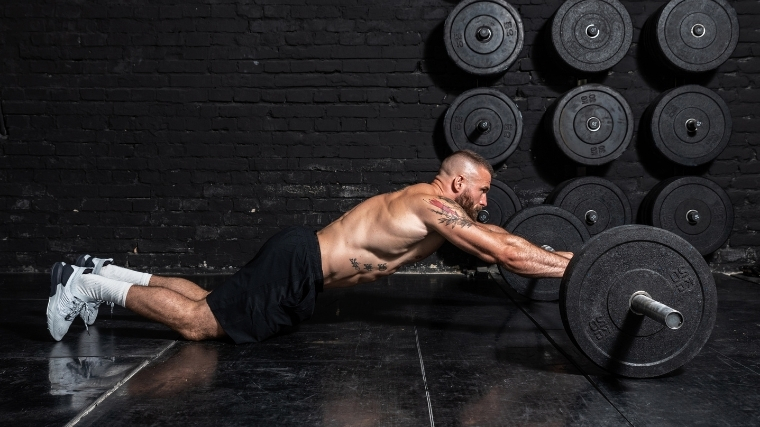To improve in any area in the gym, you need one thing: progression. A lot of lifters casually throw around the term progressive overload. They’ll often use it to refer to the process of adding more weight to the bar over time. And that’s not wrong — it is ultimately about being able to lift heavier and become an all-around stronger lifter. But there’s a lot more to progressive overload than tossing on more plates each week.
There’s a lot to know about progressive overload before you can start applying it to your training. Below, we’ll give you the full breakdown of how to progress your training regimen the right way.
What Is Progressive Overload?
In a nutshell, progressive overload is a gradual and trackable increase of stress on the body to warrant a goal-oriented adaptation. When it comes to lifting, it’s basically a recipe to keep getting stronger.
If you lift the same weight with the same rep scheme and rest periods each week, you’ll plateau. To keep stimulating growth and change, you need to progressively overload your body. Overload does not just refer to more weight on the bar. Instead, it’s good to think about it in terms of stress — how can you add more positive stress to your training program? Think: Rest periods, reps, sets, time under tension, and training frequency.
[Related: The Best Bumper Plates for Competition CrossFit, and More]
These stresses, or stimuli, should always be gradual, manageable, calculated, scalable, and trackable. This way, you can move forward safely while always heading toward your specific goal. The concept of periodization and progressive overload go hand-in-hand.
One way to think about these two is to conceptualize periodization as the physical road map you’re following. Progressive overload serves as the turns, pit stops, and gas that you need along the way to get you to your destination. Both of these will influence one another based on your training goals.
How Progressive Overload Works
Training to continuously challenge your body with new stimuli is one of the most crucial components of strength training. You’re just not going to get stronger by lifting the same weight the same way throughout your entire microcycle, let alone across macrocycles. Why? Because your body is very good at adapting to the stressors it encounters. That’s why you now (probably) warm up your squats with a weight that, at some point, was your max weight.
Your body adjusts to what you subject it to — so you need to subject it to change. Still, you don’t want to just change your lifting protocol all willy nilly. Progressive overload is a deliberate, calculated process. Sure, you can and should use some intuition and body knowledge to fine-tune your training, especially when you’re experienced. But progressive overload training is the basis of your entire program rather than your daily training protocol. In other words, you come into the gym knowing pretty much exactly what you’re doing. And the changes won’t actually look quite so dramatic. Why? Because you only want to change — overload — one variable at a time.

You don’t want to shorten your rest periods and increase your lifting intensity at once, for example. Keep your progressive overload to one variable per training program. That way, you’ll maintain safety and build a strong foundation for growth. You’ll also be able to keep track of what works best for your body by isolating the changed variable all on its own. Implementing progressive overload requires discipline and restraint. You might feel like progress isn’t progressive enough, so you decide to slap additional weight on the bar. Again, some degree of intuition is alright with experienced lifters. But in general, trust your program and use your mental toughness to stick to it (not alter it).
How to Program With Progressive Overload
The first progressive overload strategy that comes to mind for most people is training intensity. That is, how much weight is on the bar each training session. If intensity is the variable you want to program with progressive overload, it might look something like this:
- Week 1: 5×5 with 3 minute rests at 80% 1RM
- Week 2: 5×5 with 3 minute rests at 82% 1RM
- Week 3: 5×5 with 3 minute rests at 85% 1RM
You’ll notice that the number of sets, reps, and rest time remains consistent. Only the weight on the bar is changing (gradually). That’s the factor that’s being progressively overloaded. But you can also program progressive overloading into your training by manipulating variables other than weight. Say you want to make volume your training variable, specifically through progressively overloading the number of sets. That might look like this:
- Week 1: 5×5 with 3 minute rests at 80% 1RM
- Week 2: 6×5 with 3 minute rests at 80% 1RM
- Week 3: 7×5 with 3 minute rests at 80% 1RM
It may feel like you’re not actually getting stronger since the weight on the bar will stay the same. But you’re moving a lot more weight each week by adding those extra sets. And when you switch up your microcycle, that will translate into an easier time lifting heavier weight.
Not to mention you’ll be training yourself to maximize your recovery. The pattern above is pretty much how you program for progressive overload. You choose your variable based on what you’re looking to improve. And you gradually turn up that variable — and nothing else — each week. What other variables can you use to program for progressive overload? Some ideas follow:
- Intensity
- Frequency (amount of weekly training session, weekly exposures training a muscle/lift)
- Volume
- Range of Motion
- Time Under Tension (tempo)
- Angles of Lifts (incline, decline, flat)
- Type of Resistance
- Changing Workout Duration
- Manipulating Rest Periods
The Benefits Of Progressive Overload Training
Progressive overload training will help your lifting regardless of which variable you emphasize. Sure, different variables will have different specific benefits. Think: increasing your training frequency will likely improve your ability to lift more often. But they’ll all have crossover benefits and generally get you closer to where you want to be.

Break Through Your Plateaus
Generally speaking, switching up a crucial training variable will destroy your plateau. So often when your gains start to dip, you’ll just focus on piling more weight on the bar without structure. It almost always gets you nowhere fast. But progressive overload training encourages you to get more creative and more disciplined with your training at the same time.
Not able to move up in weight? Cool. Focus instead on keeping the same weight but gradually decreasing your rest time. Or, gradually increase your number of sets. Chest not growing no matter what you try? Gradually add extra training volume for your chest each week. Whatever your plateau is, you can find a progressive overload variable to help.
Get Stronger
Gradually increasing intensity (AKA weight on the bar) is only one variable. With many of the other progressive overload strategies, you might be keeping the weight the same over long periods of time. You might even start your program with a decrease in weight (if you’re increasing time under tension, for example). Regardless, progressive overload training will make you stronger.
Improve Mental Toughness
You won’t just get stronger in the sense that you’ll be lifting more weight (you will). You’ll also become a stronger overall athlete with progressive overload training. Why? You’ll be forced to maintain intense focus — not only on the goals ahead but in the moment you’re in. It takes tremendous mental toughness to perform five sets of five reps every week with the same weight.
Even if you know your rest times are decreasing, your ego doesn’t care. It likely just sees the same weight for weeks on end — and it’ll want you to slap on some more plates. Staying consistent with progressive overload training will sharpen your mental discipline. You’ll be lifting with your mind instead of your ego, which will serve your body much, much better.
How to Choose Your Weights for Progressive Overload Training
As with any programming involving percentages of intensity, you’ll want to know your 1RM. Once you do, set your reps accordingly in line with your goals. Trying for max strength? Consider starting at around 85% of your 1RM for lower reps. Going for muscle building? Think more in the 75% intensity range for a slightly higher rep range.
If you’re doing a classic progressive overload scheme, try increasing the weight by two or three percent each week. Not a fan of percentages? As a general reference point, consider increasing about five pounds for upper body work, 10 pounds for lower body work. When you’re manipulating other variables — especially frequency and time under tension — consider starting with much less weight than you would normally lift at the prescribed rep schemes. Why?

Because form can and should come before everything. If form, technique, and mechanics are sacrificed, then your efforts could be wasted. When progressively overloading anything in the gym, mechanics should always take precedence, especially when pushing past comfortable limits. One further point about picking your weights: remember that, no matter what your program says, progressive overload is never linear. Similar to data points tracked across a macrocycle in a linear periodization model, you can expect to increase weight by the same amount each week.
There will be highs and lows due to the constant variance of human life — big and small changes in sleep, hormones, diet, and environment are just some factors that will influence your performance. And then, of course, you’ll plateau — and need to change the variable up again to re-start your progress. As you progress in your lifting career, progressive overload becomes much more strategic and varied. You can’t do the same exercises and the same number of sets and reps every week and keep linearly progressing.
That often works well for beginners, but eventually, you need to experiment with different methods of progressive overload. That’s the beauty of progressive overload training, though: there are always more variables to change.
More On Progressive Overload Training
There is no one-size-fits-all methodology for progressive overload. Everyone will respond differently to various stresses and stimuli. While you’re figuring out what kind of training works best for your body, check out these articles on progressive overload training.
- 6 Easy Ways to Start Programming Progressive Overload
- 3 Alternative Overload Methods to Improve Strength and Muscle Mass
- RPE Vs. Percentage-Based Training: How to Combine Them for Better Results
Featured image: Srdjan Randjelovic/Shutterstock